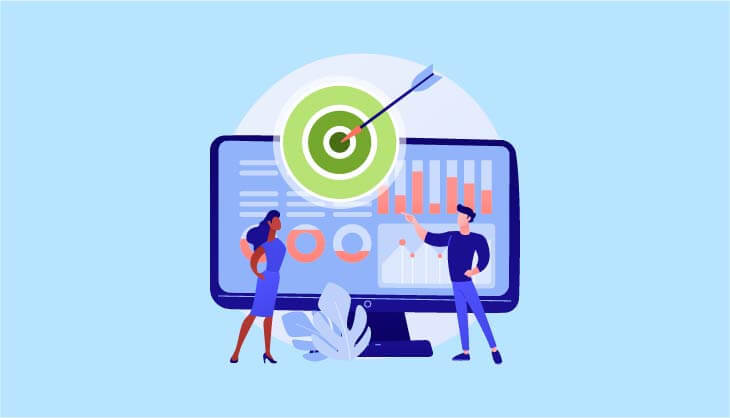Account-based marketing is a marketing tactic that emphasizes engaging multiple stakeholders and aiming to build a long-term relationship with the end goal of generating revenue. It is based on the Pareto principle. In the professional and B2B ecosystems, ABM has proved to be an effective marketing solution.
In ABM, both the sales & marketing teams make their collaborative efforts to acquire accounts that involve a lot of complexity. It is important to set up a mandatory framework at the initial stage to figure out the marketing efforts, resource involvement, level of engagement, and most importantly, the engagement flow.
-
Define your goals and target


- Define what marketing and business objectives your organization is trying to achieve by starting an ABM Strategy. Identify the key KPIs and define micro-goals. Throughout the campaign, it is important to focus on marketing cost metrics, campaign velocity, and lead qualification. This will help us to monitor our performance and keep the team motivated.
-
Understanding the Ecosystem


- Before jumping into the market, understand the market thoroughly, and figure out what is happening at the industry level. Market trends, growth drivers, industry gaps, etc. help to address the challenges, needs, and opportunities of the market. Understanding the Market ecosystem ( i.e. consumer, creator, market ) will help us to create and offer an impactful value proposition.
-
Setting up an ABM Team for better coordination


- Alignment between sales and marketing is beneficial for any organization, but if you want to get the most out of ABM, it’s crucial. Thus, the first step is the alignment of the teams, defining KPIs, and setting up weekly and monthly review processes. Despite doing this, it is not easy to manage resources. Therefore, it is advisable to have separate teams with a particular objective, where ‘The Reviewers or Auditors’ will act as an intermediate and review the work of both the teams which will enhance the coordination.
-
Finalizing your ideal customer profile


- In simple terms, an ICP is a combination of firmographics, technographic and behavioral attributes of the account that are expected to be your most catered customer. By deep-diving more into this data, you’ll have a clear understanding of which solutions to pitch, tweak or provide support for.
- This should be done with the whole team where sales and marketing can bring their lists but everyone leaves with the same shortlist.
-
Segmenting the ideal customer profile


- Tapping the right person with the right message is very crucial. Create multiple segments of ICP based on their job seniority level, industry, company size, geography, and funding. Creating such different buyers’ personas will allow you to monitor your TG closely and enable optimal feedback and communication between the prospects and the internal teams.
-
Understanding each segment


- Everything in ABM depends on a deep and reliable understanding of the audience you’re targeting. Focusing on the needs, pain points, and triggers of the customer helps you to develop an effective marketing strategy while saving time and money. For example, A CEO may not be interested to know the features of the product/offering. That person is majorly interested in a key business solution which may be a 10% growth, 10% cost reduction, etc.
-
Implementing a robust content marketing strategy


- Not everyone reacts in the same way and likes the same things. In different industries, different stakeholders respond differently to communication. Hence, it is advisable to create a robust and personalized content market strategy to engage multiple stakeholders. Along with creating content, one should not miss defining the content calendar, as the right communication message needs to be propagated at the right time to increase the engagement rate. So, one shall develop multiple communications for multiple occasions.
-
Fortify your tech stacks and enlist third-party tools


- Most marketers miss out on implementing the right tech tools, which is why it’s important to understand how your ABM will work and the intricacy involved in it.
- There are two ways to equip the teams with the tools they need to run a successful ABM program.
- Adopt an end-to-end ABM platform that provides all the necessary functionalities
- Establish an ABM program using your existing Martech stack, adding other tools to help you scale
- If unable to find a one-stop solution, find the set of tools that will fulfill the purpose and make working integrations of tools. The process may be cumbersome but it is a one-time setup and worth it.
-
Acquiring the target audience through digital mediums


- Digital mediums offer uncountable features and open an immense opportunity to acquire the right audience through multiple approaches. Either aggressively reach out to the audience or passively look for the website visitors showing intent. One suggested approach is to leverage digital media features to reach out to the TG using databases and look-alike campaigns and set up IP reversal tools like lusha to identify website visitors. Once the audience is built, define an engagement funnel and try to acquire them with remarketing strategies using digital media.
-
Keeping the leads engaged


- In the B2B industry, it is crucial to build a good relationship with the customer and keep them engaged throughout the customer lifecycle. To achieve this, one can adopt multiple strategies like inviting them to register for your newsletter, company event, and webinars, connecting on LinkedIn or sharing relevant content related to their industry, etc. Determine what’s best for you and your team and begin reconnecting with potential leads.
